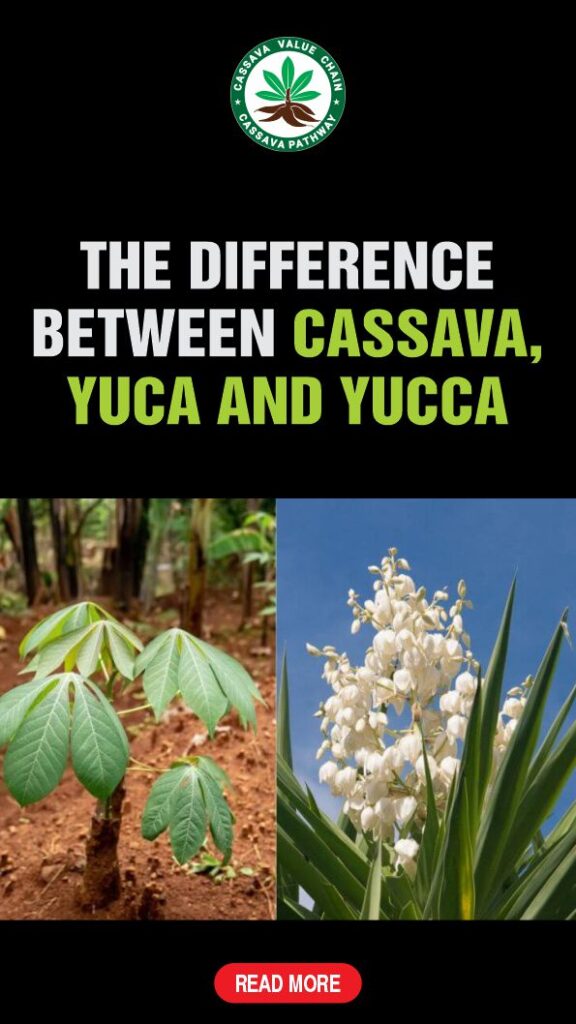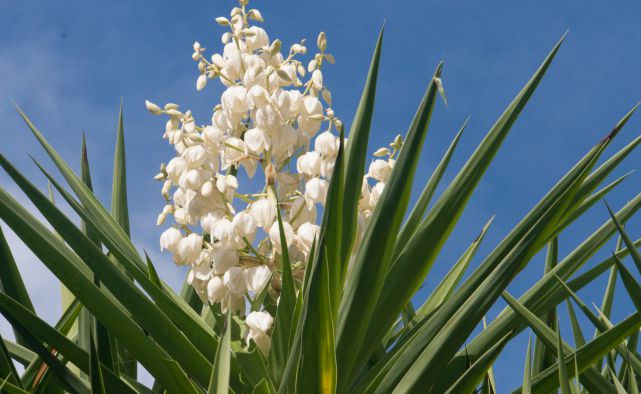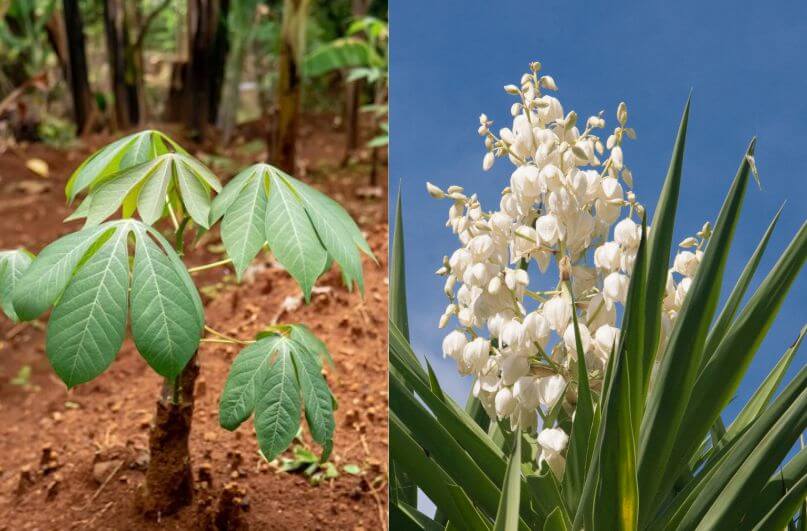Cassava root vs yuca vs yucca, are they the same or completely different? Uncover the key distinctions between these commonly confused plants and learn how each one is used in cooking and beyond!
Cassava root, yuca, and yucca, are three names that often confuse, but are they actually the same?
If you’ve ever wondered whether yuca is just another name for cassava or if yucca belongs in the same category, you’re not alone.
Many people mistakenly use these terms interchangeably, leading to misconceptions about their origins, uses, and even edibility.
While cassava and yuca share a strong connection, yucca is a completely different plant with its own distinct characteristics.
Understanding the differences between these three can help you make informed choices in the kitchen and beyond.
In this guide, we’ll break down their unique traits, culinary roles, and practical applications so you’ll never mix them up again.
Let’s set the record straight!
Related: Description of the Cassava Root

Table of Contents
- Cassava vs Yuca vs Yucca: Their Definitions
- How they are Different
- Botanical Differences and Similarities
- The Origin of the Name “Yuca” and Its Connection to Cassava
- The Emergence of “Yuca” in the Spanish-Speaking World
- The Spread of “Yuca” in Global Cuisine
- Yuca vs Manioc: Clarifying the Confusion
- The Importance of Yuca in Cultural Identity
- Cassava Root vs Yuca vs Yucca: A Common Mix-Up
- Conclusion
Cassava vs Yuca vs Yucca: Their Definitions
Cassava
Cassava (Manihot esculenta) is a root vegetable grown in tropical and subtropical regions. It is a major carbohydrate source and is processed into tapioca, cassava flour, and starch.
Raw cassava contains natural toxins that must be removed by boiling, soaking, or fermenting.
It is a staple in many countries across Africa, Asia, and Latin America and is used in both savory and sweet dishes.
Yuca
Yuca is another name for cassava, commonly used in Spanish-speaking countries. It is the same starchy tuber found in many traditional Latin American and Caribbean dishes, where it is boiled, fried, or mashed.
The name yuca is sometimes confused with yucca, a completely different plant that is not used as a food staple.
Yucca
Yucca is a plant from the Asparagaceae family, native to dry regions in North and Central America. It has spiky leaves and white flowers and is often used for landscaping.
Some parts, like the flowers and fruit, are edible, but yucca is not the same as cassava or yuca.
It is more commonly valued for its medicinal properties and fiber production.
Related: Comparing Cassava Root and Maca Root
How they are Different
1. Botanical Classification
- Cassava: A root vegetable from the Euphorbiaceae family.
- Yuca: Another name for cassava, referring to the same plant.
- Yucca: A plant from the Asparagaceae family, not related to cassava.
2. Edibility and Usage
- Cassava: Edible root used for food; must be cooked to remove toxins.
- Yuca: Same as cassava, used in Latin American and Caribbean cuisine.
- Yucca: Primarily ornamental; some parts like flowers and fruits are edible but not a staple food.
3. Growing Regions
- Cassava: Thrives in tropical and subtropical climates.
- Yuca: Grown in the same regions as cassava.
- Yucca: Found in arid and desert regions of North and Central America.
4. Appearance
- Cassava/Yuca: Brown, woody-skinned root with white flesh inside.
- Yucca: A shrub with long, pointed leaves and clusters of white flowers.
5. Culinary and Industrial Uses
- Cassava/Yuca: Used in cooking (boiled, fried, or mashed), processed into flour, starch, and tapioca.
- Yucca: Used for landscaping, traditional medicine, and fiber production.
Here’s a clear table comparing cassava, yuca, and yucca:
| Feature | Cassava | Yuca | Yucca |
|---|---|---|---|
| Botanical Family | Euphorbiaceae | Euphorbiaceae | Asparagaceae |
| Other Name | Yuca | Cassava | None |
| Edibility | Edible root, must be cooked to remove toxins | Same as cassava | Some parts (flowers, fruits) are edible but not a staple food |
| Primary Use | Food source, processed into flour, starch, and tapioca | Used in Latin American and Caribbean cuisine | Landscaping, medicine, fiber production |
| Growing Region | Tropical and subtropical climates | Same as cassava | Arid and desert regions of North and Central America |
| Appearance | Brown, woody-skinned root with white flesh | Same as cassava | Shrub with long, pointed leaves and clusters of white flowers |
Cassava and yuca are the same, while yucca is a completely different plant with non-staple edible parts.
Botanical Differences and Similarities
Cassava and yuca are terms that often create confusion among consumers, especially in various culinary contexts.
Scientifically, cassava is known as Manihot esculenta, and it belongs to the Euphorbiaceae family.
In contrast, yuca, which is the common name often used interchangeably with cassava, refers to the same species, Manihot esculenta, highlighting a shared identity.
This duality in naming primarily originates from regional linguistic preferences, as “yuca” is predominantly used in Spanish-speaking countries, while “cassava” is more frequently utilized in English-speaking areas.
Related: Soil Type Needed for High Yield of Cassava
The Origin of the Name “Yuca” and Its Connection to Cassava
How did the name “yuca” come to be associated with the cassava plant?
The Origins of the Name “Cassava”
Cassava was an important food crop for the Indigenous people of the Amazon and the wider region, offering a rich source of carbohydrates and calories.
The plant made its way to Africa, Asia, and other parts of the world through the transatlantic slave trade and European colonization, where it became a staple food in many countries.
The name “cassava” comes from the Portuguese word cassava, which itself is believed to have been derived from the Tupi word kassava.
The Tupi were an Indigenous people of Brazil, and their language played a role in naming many plants and animals that were encountered by Europeans during colonization.
The term kassava was used to describe the root of the plant, which the Portuguese later adopted.
Related: Brief History of Cassava also Called Mandioca Plant
The Emergence of “Yuca” in the Spanish-Speaking World
While “cassava” became the name for the root in English-speaking regions, the name “yuca” took hold in Spanish-speaking countries, particularly in Latin America and the Caribbean.
The exact linguistic origins of “yuca” are a bit unclear, but it is widely believed that the word was derived from the Arawakan language family, which was spoken by the Indigenous peoples of the Caribbean and northern South America.
The Arawakan language group, like the Tupi, had a significant influence on the names of various plants and foods in the region.
The word yuca could be a variation of the Arawak term for the cassava plant, used by Indigenous people to describe the root.
Over time, Spanish speakers in the Caribbean, Central America, and South America began using “yuca” to refer to cassava, and it became entrenched as the common name for the root in these regions.
Related: The Different Names of Cassava
The Spread of “Yuca” in Global Cuisine
As cassava spread globally, particularly after the Columbian Exchange, the name “yuca” became popular in the areas where Spanish was spoken, especially in the Caribbean, Mexico, and much of Central and South America.
The usage of “yuca” in these regions reflects not only linguistic adaptation but also cultural differences in the way cassava was utilized and prepared.
In many Spanish-speaking countries, yuca is a staple in everyday cuisine, where it is boiled, fried, or ground into flour to make bread, cakes, and other dishes.
It plays an integral role in the diet, particularly in tropical regions where cassava grows abundantly.
In the Caribbean, for example, yuca is used in dishes such as yuca con mojo (boiled yuca with garlic sauce), while in South America, it’s often found in dishes like pao de queijo (cheese bread) in Brazil.
Related: Benefits of Cassava Root
Yuca vs Manioc: Clarifying the Confusion
There is sometimes confusion between “yuca” and “manioc,” two terms that refer to the cassava plant.
In some regions, manioc is used to describe cassava, particularly in French-speaking areas such as parts of West Africa and the Caribbean.
“Manioc” is derived from the Portuguese word manioca, which, like “cassava,” also traces its roots back to the Tupi language.
The name “manioc” is mostly used in Europe and in areas influenced by French colonialism.
Despite the different names, yuca, manioc, and cassava all refer to the same plant.
The differences in terminology can often be attributed to the historical influences of European powers on the local languages and cultures where cassava is grown.
Related: Cassava Root vs Potato
The Importance of Yuca in Cultural Identity
The adoption of “yuca” as the name for cassava in Spanish-speaking countries is not just a matter of language; it reflects a deep connection to the cultural heritage and history of the region.
For many people in Latin America and the Caribbean, yuca is a symbol of resilience and survival.
It is a food that sustained communities through periods of hardship, and it continues to be a beloved part of their culinary traditions.
The name “yuca” carries with it the weight of centuries of cultural evolution, and it serves as a reminder of the deep-rooted ties between language, food, and identity.
Whether it’s referred to as cassava, yuca, or manioc, the significance of this humble root vegetable is undeniable.
Cassava Root vs Yuca vs Yucca: A Common Mix-Up

It is important to note that “yucca” is an entirely different plant from cassava (yuca).
Yucca refers to a genus of perennial shrubs or trees in the Agavaceae family, commonly found in arid regions of North and Central America.
Unlike cassava, yucca is not a starchy root vegetable but is instead grown for its fibrous leaves and, in some species, edible roots.
The confusion between “yuca” and “yucca” often arises because of their similar spelling and pronunciation.
However, they are botanically unrelated and should not be confused in culinary or botanical contexts.
Conclusion
In conclusion, while cassava and yuca refer to the same starchy root vegetable, the terminology varies based on regional preferences, with “cassava” commonly used in English-speaking areas and “yuca” prevalent in Spanish-speaking regions.
Despite the linguistic differences, both terms describe the same plant, Manihot esculenta, which has become a staple in global cuisines, especially in tropical regions.
On the other hand, yucca, a completely different plant from the same family, often causes confusion due to its similar name, but it is not related to cassava or yuca.
Understanding these distinctions enhances our appreciation of these plants’ cultural, culinary, and botanical significance.
References:

Chimeremeze Emeh is a writer and researcher passionate about Africa’s most transformative root crop—cassava. Through his work at cassavavaluechain.com, he explores the entire cassava industry, from cultivation and processing to its diverse applications in food, health, and industrial use.
He also writes for palmoilpalm.com, where he shares his extensive experience and deep-rooted knowledge of palm oil, covering red palm oil, palm kernel oil, and refined products. His work there reflects his lifelong connection to agriculture and his commitment to promoting sustainable value chains in Africa.
Driven by curiosity and purpose, Chimeremeze aims to shed light on how cassava continues to empower communities, strengthen food systems, and link traditional farming wisdom with modern innovation.

